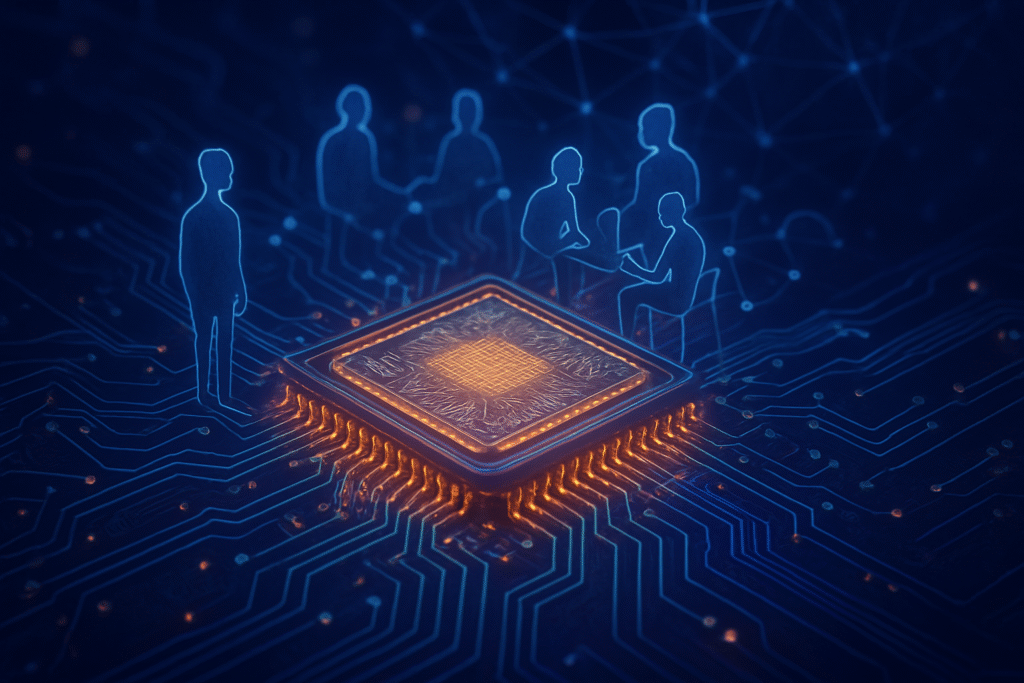
Washington D.C., October 14, 2025 – In a pivotal move set to redefine the landscape of artificial intelligence hardware innovation, the SEMI Foundation, in a strategic partnership with the U.S. National Science Foundation (NSF), has unveiled a National Request for Proposals (RFP) for Regional Nodes. This ambitious initiative is designed to dramatically accelerate and expand microelectronics workforce development across the United States, directly addressing a critical talent gap that threatens to impede the exponential growth of AI and other advanced technologies. The collaboration underscores a national commitment to securing a robust pipeline of skilled professionals, recognizing that the future of AI is inextricably linked to the capabilities of its underlying silicon.
This partnership, operating under the umbrella of the National Network for Microelectronics Education (NNME), represents a proactive and comprehensive strategy to cultivate a world-class workforce capable of driving the next generation of semiconductor and AI hardware breakthroughs. By fostering regional ecosystems of employers, educators, and community organizations, the initiative aims to establish "gold standards" in microelectronics education, ensure industry-aligned training, and expand access to vital learning opportunities for a diverse population. The immediate significance lies in its potential to not only alleviate current workforce shortages but also to lay a foundational bedrock for sustained innovation in AI, where advancements in chip design and manufacturing are paramount to unlocking new computational paradigms.
Forging the Silicon Backbone: A Deep Dive into the NNME's Strategic Framework
The National Network for Microelectronics Education (NNME) is not merely a funding mechanism; it's a strategic framework designed to create a cohesive national infrastructure for talent development. The National RFP for Regional Nodes, a cornerstone of this effort, invites proposals for up to eight Regional Nodes, each with the potential to receive substantial funding of up to $20 million over five years. These nodes are envisioned as collaborative hubs, tasked with integrating cutting-edge technologies into their curricula and delivering training programs that directly align with the dynamic needs of the semiconductor industry. The proposals for this critical RFP were due by December 22, 2025, with the highly anticipated award announcements slated for early 2026, marking a significant milestone in the initiative's rollout.
A key differentiator of this approach is its emphasis on establishing and sharing "gold standards" for microelectronics education and training nationwide. This ensures consistency and quality across programs, a stark contrast to previous, often fragmented, regional efforts. Furthermore, the NNME prioritizes experiential learning, facilitating apprenticeships, internships, and other applied learning experiences that bridge the gap between academic knowledge and practical industry demands. The NSF's historical emphasis on "co-design" approaches, integrating materials, devices, architectures, systems, and applications, is embedded in this initiative, promoting a holistic view of semiconductor technology development crucial for complex AI hardware. This integrated strategy aims to foster innovations that consider not just performance but also manufacturability, recyclability, and environmental impact.
Initial reactions from the AI research community and industry experts have been overwhelmingly positive, highlighting the urgent need for such a coordinated national effort. The semiconductor industry has long grappled with a looming talent crisis, and this initiative is seen as a robust response that promises to create clear pathways for job seekers while providing semiconductor companies with the tools to attract, develop, and retain a diverse and skilled workforce. The focus on regional partnerships is expected to create localized economic opportunities and strengthen community engagement, ensuring that the benefits of this investment are widely distributed.
Reshaping the Competitive Landscape for AI Innovators
This groundbreaking workforce development initiative holds profound implications for AI companies, tech giants, and burgeoning startups alike. Companies heavily invested in AI hardware development, such as NVIDIA (NASDAQ: NVDA), a leader in GPU technology; Intel (NASDAQ: INTC), with its robust processor and accelerator portfolios; and Advanced Micro Devices (NASDAQ: AMD), a significant player in high-performance computing, stand to benefit immensely. Similarly, hyperscale cloud providers and AI platform developers like Google (NASDAQ: GOOGL), Microsoft (NASDAQ: MSFT), and Amazon (NASDAQ: AMZN), which design custom AI chips for their data centers, will gain access to a deeper pool of specialized talent essential for their continued innovation and competitive edge.
The competitive implications are significant, particularly for U.S.-based operations. By cultivating a skilled domestic workforce, the initiative aims to strengthen U.S. competitiveness in the global microelectronics race, potentially reducing reliance on overseas talent and manufacturing capabilities. This move is crucial for national security and economic resilience, ensuring that the foundational technologies for advanced AI are developed and produced domestically. For major AI labs and tech companies, a readily available talent pool will accelerate research and development cycles, allowing for quicker iteration and deployment of next-generation AI hardware.
While not a disruption to existing products or services in the traditional sense, this initiative represents a positive disruption to the process of innovation. It removes a significant bottleneck—the lack of skilled personnel—thereby enabling faster progress in AI chip design, fabrication, and integration. This strategic advantage will allow U.S. companies to maintain and extend their market positioning in the rapidly evolving AI hardware sector, fostering an environment where startups can thrive by leveraging a better-trained talent base and potentially more accessible prototyping resources. The investment signals a long-term commitment to ensuring the U.S. remains at the forefront of AI hardware innovation.
Broader Horizons: AI, National Security, and Economic Prosperity
The SEMI Foundation and NSF partnership fits seamlessly into the broader AI landscape, acting as a critical enabler for the next wave of artificial intelligence breakthroughs. As AI models grow in complexity and demand unprecedented computational power, the limitations of current hardware architectures become increasingly apparent. A robust microelectronics workforce is not just about building more chips; it's about designing more efficient, specialized, and innovative chips that can handle the immense data processing requirements of advanced AI, including large language models, computer vision, and autonomous systems. This initiative directly addresses the foundational need to push the boundaries of silicon, which is essential for scaling AI responsibly and sustainably, especially concerning energy consumption.
The impacts extend far beyond the tech industry. This initiative is a strategic investment in national security, ensuring that the U.S. retains control over the development and manufacturing of critical technologies. Economically, it promises to drive significant growth, contributing to the semiconductor industry's ambitious goal of reaching $1 trillion by the early 2030s. It will create high-paying jobs, foster regional economic development, and establish new educational pathways for a diverse range of students and workers. This effort echoes the spirit of the CHIPS and Science Act, which also allocated substantial funding to boost domestic semiconductor manufacturing and research, but the NNME specifically targets the human capital aspect—a crucial complement to infrastructure investments.
Potential concerns, though minor in the face of the overarching benefits, include the speed of execution and the challenge of attracting and retaining diverse talent in a highly specialized field. Ensuring equitable access to these new training opportunities for all populations, from K-12 students to transitioning workers, will be key to the initiative's long-term success. However, comparisons to previous AI milestones, such as the initial breakthroughs in deep learning, highlight that hardware innovation has always been a silent but powerful partner in AI's progression. This current effort is not just about incremental improvements; it's about building the human infrastructure necessary for truly transformative AI.
The Road Ahead: Anticipating Future Milestones in AI Hardware
Looking ahead, the near-term developments will focus on the meticulous selection of the Regional Nodes in early 2026. Once established, these nodes will quickly move to develop and implement their industry-aligned curricula, launch initial training programs, and forge strong partnerships with local employers. We can expect to see pilot programs for apprenticeships and internships emerge, providing tangible pathways for individuals to enter the microelectronics workforce. The success of these initial programs will be critical in demonstrating the efficacy of the NNME model and attracting further investment and participation.
In the long term, experts predict that this initiative will lead to a robust, self-sustaining microelectronics workforce pipeline, capable of adapting to the rapid pace of technological change. This pipeline will be essential for the continued development of next-generation AI hardware, including specialized AI accelerators, neuromorphic computing chips that mimic the human brain, and even the foundational components for quantum computing. The increased availability of skilled engineers and technicians will enable more ambitious research and development projects, potentially unlocking entirely new applications and use cases for AI across various sectors, from healthcare to autonomous vehicles and advanced manufacturing.
Challenges that need to be addressed include continually updating training programs to keep pace with evolving technologies, ensuring broad outreach to attract a diverse talent pool, and fostering a culture of continuous learning within the industry. Experts anticipate that the NNME will become a model for other critical technology sectors, demonstrating how coordinated national efforts can effectively address workforce shortages and secure technological leadership. The success of this initiative will be measured not just in the number of trained workers, but in the quality of innovation and the sustained competitiveness of the U.S. in advanced AI hardware.
A Foundational Investment in the AI Era
The SEMI Foundation's partnership with the NSF, manifested through the National RFP for Regional Nodes, represents a landmark investment in the human capital underpinning the future of artificial intelligence. The key takeaway is clear: without a skilled workforce to design, build, and maintain advanced microelectronics, the ambitious trajectory of AI innovation will inevitably falter. This initiative strategically addresses that fundamental need, positioning the U.S. to not only meet the current demands of the AI revolution but also to drive its future advancements.
In the grand narrative of AI history, this development will be seen not as a single breakthrough, but as a crucial foundational step—an essential infrastructure project for the digital age. It acknowledges that software prowess must be matched by hardware ingenuity, and that ingenuity comes from a well-trained, diverse, and dedicated workforce. The long-term impact is expected to be transformative, fostering sustained economic growth, strengthening national security, and cementing the U.S.'s leadership in the global technology arena.
What to watch for in the coming weeks and months will be the announcement of the selected Regional Nodes in early 2026. Following that, attention will turn to the initial successes of their training programs, the development of innovative curricula, and the demonstrable impact on local semiconductor manufacturing and design ecosystems. The success of this partnership will serve as a bellwether for the nation's commitment to securing its technological future in an increasingly AI-driven world.
This content is intended for informational purposes only and represents analysis of current AI developments.
TokenRing AI delivers enterprise-grade solutions for multi-agent AI workflow orchestration, AI-powered development tools, and seamless remote collaboration platforms.
For more information, visit https://www.tokenring.ai/.


















